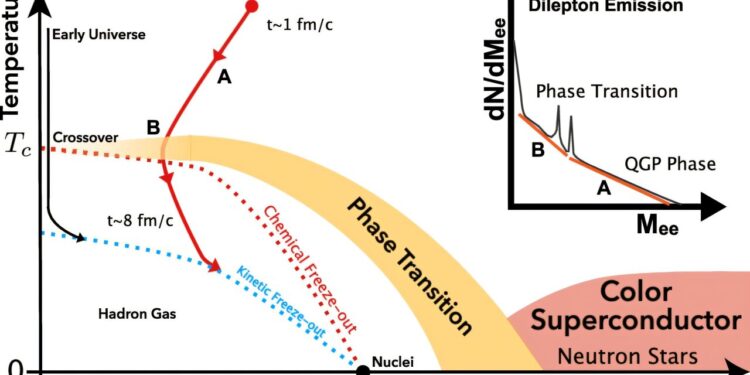A schematic view of e+e− pair production and the QCD phase diagram. Credit: Natural communications (2025). DOI: 10.1038/s41467-025-63216-5
A research team led by Rice University physicist Frank Geurts has successfully measured the temperature of quark-gluon plasma (QGP) at various stages of its evolution, providing essential information about a state of matter that may have existed just microseconds after the Big Bang, a scientific theory describing the origin and evolution of the universe.
The results are published in Natural communications.
The study addresses the long-standing challenge of measuring the temperature of matter in extreme conditions where direct access is impossible.
Using thermal electron-positron pairs emitted during ultrarelativistic heavy ion collisions at the Relativistic Heavy Ion Collider (RHIC) at Brookhaven National Laboratory in New York, the researchers decoded the thermal profile of the QGP.
Temperature measurements existed before, but they were plagued by several complications, notably if they concerned the QGP phase or if they were biased by a Doppler-like effect due to the large velocity fields pushing such effective temperatures.
“Our measurements reveal the thermal footprint of QGP,” said Geurts, professor of physics and astronomy and co-spokesperson for the RHIC STAR collaboration.
“Tracking dilepton emissions allowed us to determine the temperature of the plasma and when it began to cool, providing a direct view of conditions just microseconds after the creation of the universe.”
New thermal window on nuclear material
The properties of QGP, a deconfined state of quarks and gluons, depend strongly on its temperature. Previous methods did not have the resolution or penetrating power necessary to measure the internal thermal conditions of the QGP without being affected by the evolution of this rapidly expanding system. With temperatures expected to exceed billions of Kelvins, scientists needed a discreet thermometer to capture the values in real time.
“Thermal lepton pairs, or electron-positron emissions produced throughout the lifetime of the QGP, emerged as ideal candidates,” Geurts said.
“Unlike quarks, which can interact with plasma, these leptons pass through it largely unscathed, carrying undistorted information about their environment.”
However, detecting these rare pairs amid a sea of particle debris required unprecedented sensitivity and data fidelity, Geurts said.
Frank Geurts is a professor of physics and astronomy at Rice and co-spokesperson for the RHIC STAR collaboration. Credit: Jeff Fitlow/Rice University.
Experimental breakthrough
The researchers used a refined detection apparatus at RHIC, calibrating their systems to isolate low-momentum lepton pairs.
They tested the hypothesis that the energy distribution of these pairs would provide a direct measure of the temperature of the QGP. This technique, called penetration thermometer in theoretical discussions, integrates emission data over the entire lifetime of the plasma, thereby producing an average temperature profile.
The research team obtained an accurate measurement despite the technological limitations of statistical data and the difficulties encountered in isolating background processes that could mimic thermal signals.
Main conclusions and implications
The study revealed two distinct average temperatures depending on the dielectron pair mass range: a lower temperature of about 2.01 trillion Kelvin in the low-mass region, predicted by theoretical models and consistent with the freezing temperatures of hadronic probes, and a significantly higher temperature of about 3.25 trillion Kelvin in the higher pair mass region.
This difference indicates that the low-mass thermal radiation, which creates these dielectrons, is mainly emitted later, near the phase transition. In contrast, those in the higher mass range originate from the earlier, warmer stage of QGP evolution.
“This work reports QGP mean temperatures at two distinct stages of evolution and multiple baryonic chemical potentials, marking a significant advance in mapping the thermodynamic properties of QGP,” Geurts said.
By precisely measuring the temperature of the QGP at different times during its evolution, scientists obtain crucial experimental data needed to complete the “QCD phase diagram,” essential for mapping the behavior of fundamental matter under immense heat and density, similar to the conditions that existed moments after the Big Bang and are present in cosmic phenomena like neutron stars.
“Armed with this heat map, researchers can now refine their understanding of the QGP lifetime and its transport properties, thereby improving our understanding of the early universe,” Geurts said.
“This advance means more than a measurement; it heralds a new era in the exploration of the furthest frontiers of matter.”
More information:
Quark-Gluon plasma temperature measurement at different stages, Natural communications (2025). DOI: 10.1038/s41467-025-63216-5
Provided by Rice University
Quote: Physicists probe quark-gluon plasma temperatures, helping to paint a more detailed picture of the Big Bang (2025, October 15) retrieved October 15, 2025 from
This document is subject to copyright. Except for fair use for private study or research purposes, no part may be reproduced without written permission. The content is provided for informational purposes only.



